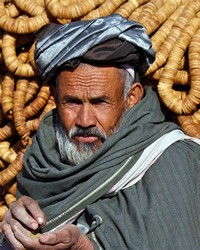Pashtun, Southern in Iran

Photo Source:
chiplanay - Pixabay
|
Send Joshua Project a map of this people group.
|
| People Name: | Pashtun, Southern |
| Country: | Iran |
| 10/40 Window: | Yes |
| Population: | 176,000 |
| World Population: | 9,558,900 |
| Primary Language: | Pashto, Southern |
| Primary Religion: | Islam |
| Christian Adherents: | 0.02 % |
| Evangelicals: | 0.00 % |
| Scripture: | Portions |
| Ministry Resources: | Yes |
| Jesus Film: | Yes |
| Audio Recordings: | Yes |
| People Cluster: | South Asia Muslim - Pashtun |
| Affinity Bloc: | South Asian Peoples |
| Progress Level: |
|
Introduction / History
The Pashtun have been called the largest Muslim tribal society in the world. There are at least 30 major tribes, and countless sub-tribes and clans. Spread over a vast geographical area and driven by socio-economic, political, tribal and linguistic (dialectical) differences, Pashtuns nevertheless share a unique sense of common identity. Pashtun identity is based on four elements: Heritage (descent from a common ancestor); Islam (99.9% Muslim); the Pashtunwali Code of Honor ("The Way of the Pashtun"); and to some extent, Language (Pakhtu or Pashto). They live primarily in Afghanistan and Pakistan, though there is a significant Pashtun diaspora in the Arab Gulf, especially the UAE, and many Western countries. There is a very large number of Pashtuns in neighboring Iran.
There have been efforts to reach the Pashtun since 1818, when William Carey translated parts of the Old Testament into Pakhto, based on interaction with Pashtun traders who caravanned (and settled) across north India and beyond. (In South Asia, the name "Pashtun/Pakhtun" was anglicized to "Pathan"—a name immortalized in Rudyard Kipling's novels and British colonial history; today, the Pashtun in India, Bangladesh, and throughout South Asia are known as "Pathan".) The first intentional mission to the Pashtun was launched by the Church Missionary Society in Peshawar, Pakistan in 1853. This was followed by over 150 years of faithful witness, through mission hospitals, schools, colleges, literature, friendship evangelism, and other forms of witness by national Pakistani (Punjabi) Christians and expatriate missionaries. Despite this record and the slow but growing number of scattered Pashtun believers, a vibrant, indigenous, disciple-making movement has yet to take root and spread.
The Pashtun are the largest people group among Afghanistan's peoples. More significant than dialectical differences, a Pashtun's primary loyalty is to his particular social group (tribe or sub-tribe). The Pashtun were the traditional rulers of Afghanistan for over 250 years. Since the overthrow of the Afghan king, communist coup and Soviet invasion in the 1970s, Afghanistan has been in a state of constant conflict. In the 1970's and 1980 's, the Pakistan-Afghanistan borderlands were the launchpad for mujahideen ("freedom fighters") who, with Western, Saudi, and global support, resisted and overthrew the communist regime. The cost was high; over 3.5 million refugees settled into hundreds of refugee camps in border provinces of Iran and Pakistan and one-third of the Pashtun population was displaced.
During the 1990 's, Pashtun tribal areas and thousands of Arab-funded madrassas (religious schools) throughout Pakistan, became the seedbed for the rise of the Taliban movement. Driven by a combination of religious zeal and Pashtun nationalism, and fueled by Arab money, the "Taliban" (a term for "religious students") imposed a harsh, hyper-conservative (Wahabi) version of Islam on the country. Unfortunately, attempts toward a peace accord and durable central government have, to date, been unsuccessful. Armed opposition continues. As a result, there is a steady stream of Pashtuns leaving their homeland for safer countries.
Where Are they Located?
The majority of Pashtun live in Pakistan, but there are Pashtuns in many other countries as well. You can find them in other Central Asian countries like Kyrgyzstan and Tajikistan. There is a sizable Pashtun population in Iran.
What Are Their Lives Like?
Some Pashtuns are being driven out of Iran by the government, while others are fleeing because of the worsening economy. There will probably be more people crossing the border both ways for years to come.
What Are Their Beliefs?
Pashtuns almost always identify themselves as Sunni Muslims. They will be married in a Sunni mosque, and to be associated with another religious system would be unacceptable in their community. Those who want to take Christ to the Pashtuns will need to do just that; take Christ to them, not a religious system.
The Pashtunwali Code of Honor erodes among Pashtuns who live in other settings like in Iran. They need to find their identity in the Savior who loves them and wants them to be transformed into His likeness.
No one knows how many Pashtuns are following Jesus. Seeds of the gospel have been sown widely. The greatest barriers to faith are social and cultural, leaving us with the challenge of allowing Pashtuns to embrace Christ while keeping their culture and traditions. Iranian believers, who have learned how to overcome many spiritual barriers, might be the best people to take Christ to them.
Prayer Points
Pray for the Church in Iran to use this opportunity to reach the Pashtuns in their midst for Christ and His kingdom.
Pray for a movement to Christ among the Pashtuns Diaspora that will spread far and wide.
Pray for the production and distribution of all forms of media in the Pashto language for the Pashtun Diaspora.
Pray for more workers to live among the Pashtuns and work beside them, giving them the opportunity to tell them about Jesus Christ, the Savior of all nations.
Pray for God's Spirit to strengthen and protect new believers and to empower them to take Christ to other Pashtun communities.